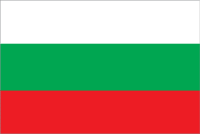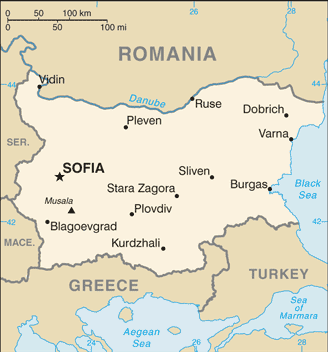Topics Covered
Welcome to Bulgaria
Overview of Resources
Metals
Industrial Minerals
Fossil Fuels
Investment
Sources
Welcome to Bulgaria
Bulgaria is located in southeastern Europe between Turkey and Romania. The total area of the country is 110,879 km2, and it has a population of 7,037,935 as of July 2012. The country’s climate is mostly temperate.
 |
The national flag of Bulgaria.
Image Credit: CIA Factbook. |
Bulgaria was under the influence of the Soviet for a long time and only in 1990 the communist supremacy ended when Bulgaria conducted its first multiparty election. Since then the country has been moving towards political democracy. The country became a part of NATO in 2004 and the EU in 2007.
Over the years, the various ruling parties have promoted economic reforms and proper fiscal agendas; however, the economic downturn of 2009 affected Bulgaria’s economy as domestic demand and industrial production reduced. Corruption in public administration has also slowed down the country’s growth and hampered economic investments and prospects. The GDP of Bulgaria as of 2011 was $102.3 billion.
The natural resources of Bulgaria include coal, bauxite, copper, zinc, and lead. The mining industry caters mainly to regional demands and is small scale.
Overview of Resources
The mineral industry of Bulgaria produced metal ores, mineral fuels (especially coal), and a number of industrial minerals in 2010. The metallurgical sector smelted and refined silver, steel, zinc, copper, and lead.

The map of Bulgaria. Image Credit: CIA Factbook
Metals
In 2010, Dundee Precious Metals Inc. of Canada procured a long-term loan agreement with the European Bank for Reconstruction and Development and Unicredit Bulbank for $66.75 million. The company used the loan to pay for the expansion operations of the $150 million Chelopech copper Mine and Mill. The production of the mine and the mill was estimated to reach 2 million Mt/yr of ore.
Similarly, in June of the same year, Euromax Resources Ltd. of Canada began drilling at its project in Breznik and had located high-grade gold-silver deposit close to 2,200 m.
Industrial Minerals
Cement production in Bulgaria reduced in 2010 due to the decline in cement consumption by almost 22.4%. Sales of cement and clinker by the country’s top producers dropped by 33.4% as well. Experts state that lack of investment was also stated as a reason for this decrease.
Fossil Fuels
In 2009, Melrose Resources S.a.r.l. stopped production at its Galata natural gas field in the Black Sea as the field had mostly depleted. This field was the only source of natural gas production in Bulgaria. However, Melrose once again began production at two offshore fields in the Black Sea in the latter part of 2009. The two offshore fields are:
- Kaliakra deposit with estimated reserves of 1.4 billion m3
- Kavarna deposit with estimated reserves of 0.7 billion m3
The major activity in Bulgaria’s natural gas sector throughout 2009 was related to the Nabucco natural gas pipeline project. Bulgaria along with Romania, Austria, Hungary, and Turkey made a joint agreement on basic legal rules and tariff regulations for the project. The significance of this project is that on completion it will be an alternative supply route for natural gas to Europe from Central Asia and the Middle East. It will have the capacity to transporting 31 billion m3 per year.
Mini Maritsa Iztok EAD was the chief producer of coal in Bulgaria with an estimated 95% of lignite production in 2010.
Investment
In 2011, the increasing demand for gold attracted Canada’s Dundee Precious Metals along with its Bulgarian subsidiary, Balkan Mineral & Mining, to start a big open-pit gold mine near Krumovgrad. There was a lot of opposition for this project from the locals and environmental agencies. The government, however, granted a provisional license to the company.
The government of Bulgaria is slowly promoting its mining sector and working its way to ensuring better investment environment. In the meantime, local demand for mineral commodities (especially as gold, copper, lead and zinc) is likely to increase as the economic activity in the country increases. Experts predict that the growth levels of the mining sector will be maintained at 6.7% in 2012, and by 2014, growth in the sector is expected to increase by 5.8% and will be valued at $ 1.07 billion.
Disclaimer: The Author of this article does not imply any investment recommendation and some content is speculative in nature. The Author is not affiliated in any way with any companies mentioned and all statistical information is publically available.
Sources
Disclaimer: The views expressed here are those of the author expressed in their private capacity and do not necessarily represent the views of AZoM.com Limited T/A AZoNetwork the owner and operator of this website. This disclaimer forms part of the Terms and conditions of use of this website.